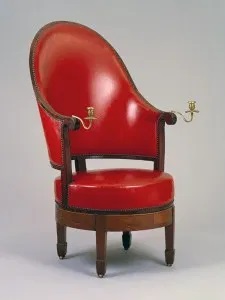On the Hunt for French Material Culture in the Land of Midnight Sun
The announcement for the Decorative Arts Trust’s recent Study Trip Abroad “Sweden and Denmark: Scandinavian Castles and Collections” caught my attention even though my specialty is Monticello and its material culture. Although headed to Nordic countries, my curatorial appetite was whetted because I knew the itinerary would contain many rare examples of French decorative arts! French art and architecture set trends around the western world in the late 18th century, but the Swedes in particular were as influenced by French art and architecture as Thomas Jefferson, who lived in Paris from 1784 until 1789. After a series of unexpected events, I found myself in Stockholm with a welcoming group of Trust travelers, who proved to be engaged learners and great fun too.

Revolving Armchair or Fauteuil de Bureau, probably Paris, c. 1785. Photo courtesy of Diane Ehrenpreis.
Of all the historic and aesthetically impressive sites, the one that I was most keen to visit was Haga Park with its Neoclassical Gustav III Pavilion. Built for the king in 1784, it was designed by Olaf Templeman and decorated in the French manner by Louis Masreliez.[1] The interiors offered a smörgåsbordof French furnishings, or Swedish examples in the French style, including gilded mirrors, wallpaper treatments, bed alcoves with blue-gray silk curtains and alcove beds, and most exciting of all, a revolving armchair, or a fauteuil de bureauin French, (fig. 1) designed for gentlemen to use at a desk.[2] The royal example has fluted legs, carved rosettes, gilded brass bosses and trim, as well as faded leather upholstery over a comfortably padded back and seat. The chair can be easily moved because of its casters, rotating to enable the sitter to work more efficiently by saving time and motion.

Revolving Armchair, attributed to Thomas Burling, New York, 1790
(c) Thomas Jefferson Foundation at Monticello.
This handsome and innovative chair was available to only the wealthiest patrons, which apparently did not include Jefferson. Despite the haul of furniture that returned to America when Jefferson gave up his post as Minister to France, it did not include a fauteuil de bureau. Instead, he commissioned one almost immediately upon arriving in New York City, charging the cabinetmaker Thomas Burling with the job. Jefferson’s revolving chair (fig. 2) survives today as one of the most important objects in the collection at Monticello. From 1790, when he took possession of it, until his death in 1826, this is the chair that Jefferson used almost daily when working on his correspondence. The Burling version has the same overall features as the high style example at Haga Park, but the form is less refined and the decorative elements have been eliminated. A great-grandchild told journalist Frank Stockton that “In . . . his study, stood Mr. Jefferson’s writing-chair which was made to suit his peculiar needs; the chair itself was high-backed, well rounded, and cushioned. . .”[3] Jefferson used his armchair in his cabinet, or study, at Monticello, where he executed his vast correspondence. It appears that this placement and function is in keeping with how King Gustav used his own example in the library of the Pavilion at Haga Park. Having the rare opportunity to consider a fauteuil de bureau in its original setting, both at Monticello and Gustav III’s Pavilion, was an invaluable experience. My own modern turning office chair is directly related to the innovations in seating promoted by these two Francophiles, and others like them.
N.B. Diane Ehrenpreis would like to thank the Decorative Arts Trust and the Thomas Jefferson Foundation for their support of this trip. She would welcome the opportunity to greet her travel mates and invites them to come see the Jefferson armchair at Monticello. Please visit our website https://home.monticello.org/
[1]For more on Haga Park and the Pavilion: see https://en.wikipedia.org/wiki/Gustav_III%27s_Pavilion
[2]For more on this type of chair see: Wolfram Koeppe, Extravagant Inventions: The Princely Furniture of the Roentgens(New York: Metropolitan Museum of Art, 2012), 167-169.
[3] Frank R. Stockton, “The Later Years of Monticello,” Century Illustrated Magazine, XXXIV, no. 5 (September 1887): 654. This armchair is owned by the Thomas Jefferson Foundation. See: Susan R. Stein, The Worlds of Thomas Jefferson at Monticello(New York: Harry N. Abrams, 1993), 266-267. George Washington also had a version of the revolving chair made by Burling.
About The Decorative Arts Trust Bulletin
Formerly known as the "blog,” the Bulletin features new research and scholarship, travelogues, book reviews, and museum and gallery exhibitions. The Bulletin complements The Magazine of the Decorative Arts Trust, our biannual members publication.







